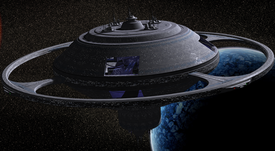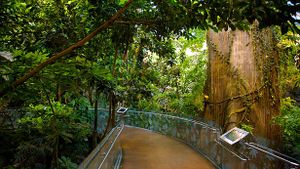Tyrellian system: Difference between revisions
(Adding a location simmed a few years ago.) |
m (→Iana Station: The Eternal Party: added the RapTram) |
||
| Line 59: | Line 59: | ||
Iana Station is a Tyrellian space station that primarily serves as a trade hub and orbital repair facility for the starships that visit the system. Many of the permanent population are engineers or civil servants, and are a mix of Tyrellian and Starfleet personnel. The station is particularly known for its entertainment decks, and one in particular is devoted to a permanent nightlife, hosting pubs, clubs and restaurants to entertain the crews of docked ships, as well as many visitors from Tyrellia itself. | Iana Station is a Tyrellian space station that primarily serves as a trade hub and orbital repair facility for the starships that visit the system. Many of the permanent population are engineers or civil servants, and are a mix of Tyrellian and Starfleet personnel. The station is particularly known for its entertainment decks, and one in particular is devoted to a permanent nightlife, hosting pubs, clubs and restaurants to entertain the crews of docked ships, as well as many visitors from Tyrellia itself. | ||
The rapid transport tram, shortened RapTram, provides quick transport to the different sections and districts of the Station. <ref>https://groups.google.com/g/sb118-gorkon/c/Z4H3NKpOLuA/m/QjkM5dIKBAAJ </ref> | |||
===<font color=DarkBlue>Ereina: The Colonised "Ark" Moon</font>=== | ===<font color=DarkBlue>Ereina: The Colonised "Ark" Moon</font>=== | ||
Revision as of 12:59, 6 June 2022
| Tyrellian Sector | |||||||||||
|---|---|---|---|---|---|---|---|---|---|---|---|

| |||||||||||
| |||||||||||
The Tyrellian system is a binary star system in the Tyrellian Sector, located in the Beta Quadrant. It is home to the Tyrellian species and a member of the United Federation of Planets. Located close to the Federation-Klingon border, and the Romulan Neutral Zone, it has become a diplomatic and trade hub between the three political powers.
Stars
Denak A and B form a detached binary (i.e. there is no mass transfer between them) in close orbit around a common barycenter.
| Name | Classification | Mass (M☉) |
Temperature (K) |
Age (Gyr) |
|---|---|---|---|---|
| Denak A | G (Yellow) | 1.22 | 6210 | 4.4 |
| Denak B | G (Yellow) | 0.72 | 5390 | 4.4 |
Planets and Moons
Overview
- Planets: 11, in P-type (circumbinary) orbits
- Habitable planets: 1, Tyrellia. It is the 5th planet, the original homeworld of the Tyrellians, and currently habitable only through artificial means.
- Habitable moons: Palanon, Ereina and Senya, all in orbit of Palan, the 6th planet, a large blue gas giant.
The Tyrellian system has 4 inhabited worlds and 2 species native to the system. The inner part of the system and its habitable worlds are protected by a defence grid with advanced sensors, capable of detecting the approach of cloaked vessels.
Palanon: The Capital World
- Name: Palanon
- Classification: Class-M moon
- Population: ≈ 3.4 billion
The vast majority of the Tyrellian population do not live on their homeworld, but rather the largest of the habitable moons in the system, having migrated there after their homeworld was rendered uninhabitable by a natural disaster.
The world is an exemplification of the attitude "aim for peace, but prepare for war" that pervades modern Tyrellian culture. The whole system is well-protected by an array of early warning systems, as well as a standing fleet of Starfleet vessels. Palanon itself boasts an array of planetary defence systems that are among the most potent in the Federation. Despite this, the desire to live peacefully with their neighbours is in clear evidence. The capital city, Yarista, hosts numerous embassies, including major diplomatic missions from the Romulan Star Empire, the Klingon Empire, and the Ferengi Alliance, amongst others. Visitors are welcomed, and the population is diverse.
Other major cities on Palanon include Cotral.
Known holiday spots in the northern hemisphere include Cyrithra Forest, a popular spot for hikers and campers, and the Mindirra mountain range in the northern hemisphere, where skiing and many other winter sports are available for visitors to enjoy.[1]
Iana Station: The Eternal Party
- Name: Iana Station
- Classification: Space station and orbital drydock
- Population: ≈ 5000 crew, 15000 civilians.
Iana Station is a Tyrellian space station that primarily serves as a trade hub and orbital repair facility for the starships that visit the system. Many of the permanent population are engineers or civil servants, and are a mix of Tyrellian and Starfleet personnel. The station is particularly known for its entertainment decks, and one in particular is devoted to a permanent nightlife, hosting pubs, clubs and restaurants to entertain the crews of docked ships, as well as many visitors from Tyrellia itself.
The rapid transport tram, shortened RapTram, provides quick transport to the different sections and districts of the Station. [2]
Ereina: The Colonised "Ark" Moon
- Name: Ereina
- Classification: Class-M moon
- Population: ≈ 350,000
Ereina is an "ark world", colonised by the Tyrellians with a view to preserving as much life from their home planet as possible. Much of the moon's surface and seas are enclosed within biodomes simulating the conditions of Tyrellia's original biomes. Access is restricted to scientific and educational visits only -- with the occasional tour for diplomats -- and the planet's inhabitants primarily consist of scientists, facility staff, and their families.
Senya: The Cradle of Another Civilisation
- Name: Senya
- Classification: Class-M moon
- Population: ≈ 1.2 billion
The third of Palan's habitable moons, Senya, is home to another sentient species, currently in the E- technological age. Their development is rapid, and estimations are that they will be launching their first space missions within the next few years. Various groups within the Tyrellian people and the Federation at large are in heated debate over when to make contact -- though the species is far from reaching the Federation's usual requirements for first contact, their close proximity means will encounter the Tyrellians long before they have developed warp drive.
Tyrellia: The Desolate Homeworld
The homeworld of the Tyrellians is unique within the Federation, known for being only one of three inhabited planets to lack a magnetic pole, and one of only seven without any kind of atmosphere. [3] This unusual situation is due to the as yet unexplained loss of the planet's geomagnetic field, which ultimately resulted in total atmospheric ablation by the solar winds of the binary stars.
While their homeworld grew more hostile to life, the Tyrellians created deep underground shelters, preparing to migrate their population to the first of Palan's habitable moons, Palanon, while the flora and fauna were to be moved to another habitable moon, Ereina. It is in these shelters that the current population live, protected from the intense solar radiation that bombards the planet's surface. A substantial part of this small population is an array of scientists dedicated to finding an answer to why the planet lost its geomagnetic field, and how it could be reestablished. Also present in large numbers are archeologists and engineers, dedicated to preserving the structures -- both underground and overground -- for the day when the Tyrellians can return home.
Additionally, Starfleet has taken advantage of the planet's unique circumstances to establish a large space observatory complex.
Denak IX
The ninth planet of the Tyrellian system is a Class K body, primarily yellow in colour. Surface features include a petrified stone "forest", valleys and mountains.
It has not been colonised by the Tyrellians and is mostly uninhabited except for a concealed listening station, part of the Tyrellian defence grid, [4] and a renowned spa built over a natural geyser, which attracts bathers and tourists all year round [5].
It is also host to an annual triathlon involving an orbital skydive from 60km above the surface, a 5 kilometre EVA suit "run", and a 25km all-terrain vehicle drive to the finish [6].
References
- ↑ Flt. Cpt. Reynolds - "Let It Snow".
- ↑ https://groups.google.com/g/sb118-gorkon/c/Z4H3NKpOLuA/m/QjkM5dIKBAAJ
- ↑ "Starship Mine", Star Trek: The Next Generation
- ↑ Lt. Caedan Nkai - "Coming Home".
- ↑ Lt. Commander Jo Marshall - "Party In A Dropzone".
- ↑ Lt. Commander Jo Marshall - "Party In A Dropzone".






